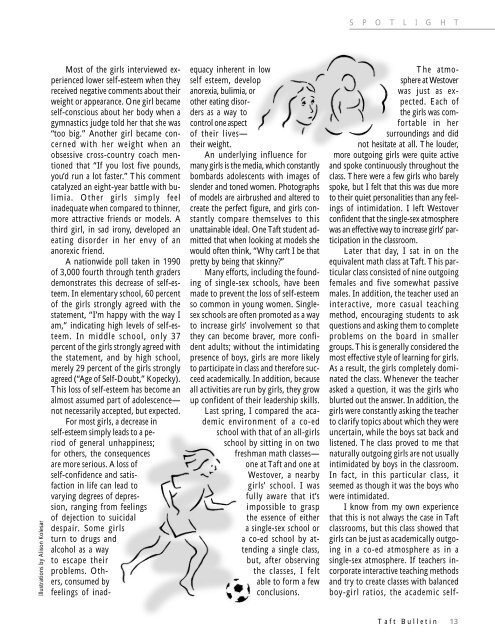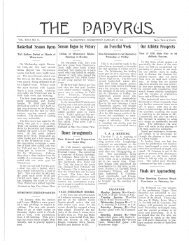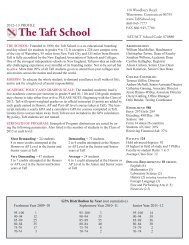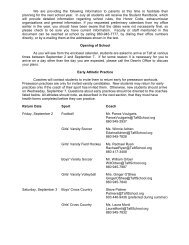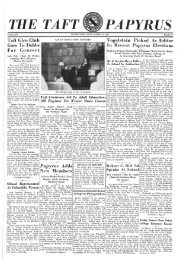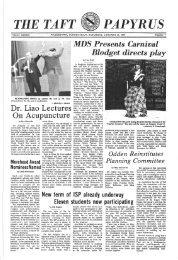By Lauren Henry '99 - The Taft School
By Lauren Henry '99 - The Taft School
By Lauren Henry '99 - The Taft School
- No tags were found...
You also want an ePaper? Increase the reach of your titles
YUMPU automatically turns print PDFs into web optimized ePapers that Google loves.
S P O T L I G H TIllustrations by Alison KolesarMost of the girls interviewed experiencedlower self-esteem when theyreceived negative comments about theirweight or appearance. One girl becameself-conscious about her body when agymnastics judge told her that she was“too big.” Another girl became concernedwith her weight when anobsessive cross-country coach mentionedthat “If you lost five pounds,you’d run a lot faster.” This commentcatalyzed an eight-year battle with bulimia.Other girls simply feelinadequate when compared to thinner,more attractive friends or models. Athird girl, in sad irony, developed aneating disorder in her envy of ananorexic friend.A nationwide poll taken in 1990of 3,000 fourth through tenth gradersdemonstrates this decrease of self-esteem.In elementary school, 60 percentof the girls strongly agreed with thestatement, “I’m happy with the way Iam,” indicating high levels of self-esteem.In middle school, only 37percent of the girls strongly agreed withthe statement, and by high school,merely 29 percent of the girls stronglyagreed (“Age of Self-Doubt,” Kopecky).This loss of self-esteem has become analmost assumed part of adolescence—not necessarily accepted, but expected.For most girls, a decrease inself-esteem simply leads to a periodof general unhappiness;for others, the consequencesare more serious. A loss ofself-confidence and satisfactionin life can lead tovarying degrees of depression,ranging from feelingsof dejection to suicidaldespair. Some girlsturn to drugs andalcohol as a wayto escape theirproblems. Others,consumed byfeelings of inadequacyinherent in lowself esteem, developanorexia, bulimia, orother eating disordersas a way tocontrol one aspectof their lives—their weight.An underlying influence formany girls is the media, which constantlybombards adolescents with images ofslender and toned women. Photographsof models are airbrushed and altered tocreate the perfect figure, and girls constantlycompare themselves to thisunattainable ideal. One <strong>Taft</strong> student admittedthat when looking at models shewould often think, “Why can’t I be thatpretty by being that skinny?”Many efforts, including the foundingof single-sex schools, have beenmade to prevent the loss of self-esteemso common in young women. Singlesexschools are often promoted as a wayto increase girls’ involvement so thatthey can become braver, more confidentadults; without the intimidatingpresence of boys, girls are more likelyto participate in class and therefore succeedacademically. In addition, becauseall activities are run by girls, they growup confident of their leadership skills.Last spring, I compared the academicenvironment of a co-edschool with that of an all-girlsschool by sitting in on twofreshman math classes—one at <strong>Taft</strong> and one atWestover, a nearbygirls’ school. I wasfully aware that it’simpossible to graspthe essence of eithera single-sex school ora co-ed school by attendinga single class,but, after observingthe classes, I feltable to form a fewconclusions.<strong>The</strong> atmosphereat Westoverwas just as expected.Each ofthe girls was comfortablein hersurroundings and didnot hesitate at all. <strong>The</strong> louder,more outgoing girls were quite activeand spoke continuously throughout theclass. <strong>The</strong>re were a few girls who barelyspoke, but I felt that this was due moreto their quiet personalities than any feelingsof intimidation. I left Westoverconfident that the single-sex atmospherewas an effective way to increase girls’ participationin the classroom.Later that day, I sat in on theequivalent math class at <strong>Taft</strong>. This particularclass consisted of nine outgoingfemales and five somewhat passivemales. In addition, the teacher used aninteractive, more casual teachingmethod, encouraging students to askquestions and asking them to completeproblems on the board in smallergroups. This is generally considered themost effective style of learning for girls.As a result, the girls completely dominatedthe class. Whenever the teacherasked a question, it was the girls whoblurted out the answer. In addition, thegirls were constantly asking the teacherto clarify topics about which they wereuncertain, while the boys sat back andlistened. <strong>The</strong> class proved to me thatnaturally outgoing girls are not usuallyintimidated by boys in the classroom.In fact, in this particular class, itseemed as though it was the boys whowere intimidated.I know from my own experiencethat this is not always the case in <strong>Taft</strong>classrooms, but this class showed thatgirls can be just as academically outgoingin a co-ed atmosphere as in asingle-sex atmosphere. If teachers incorporateinteractive teaching methodsand try to create classes with balancedboy-girl ratios, the academic self-<strong>Taft</strong> Bulletin 13


